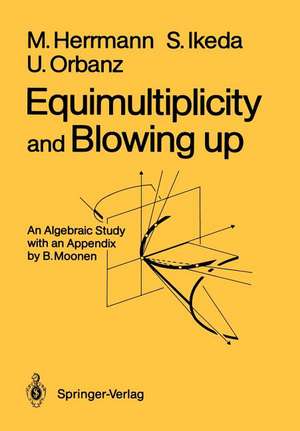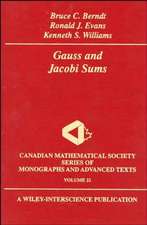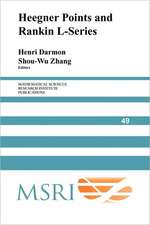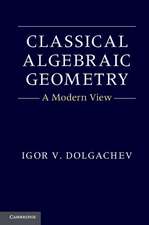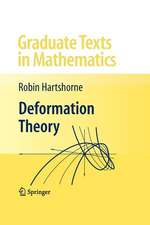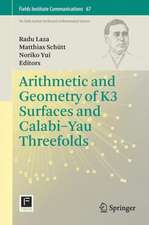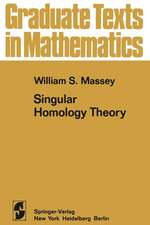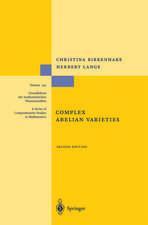Equimultiplicity and Blowing Up: An Algebraic Study
Apendix de B. Moonen Autor Manfred Herrmann, Shin Ikeda, Ulrich Orbanzen Limba Engleză Paperback – 12 oct 2011
Preț: 414.14 lei
Nou
Puncte Express: 621
Preț estimativ în valută:
79.24€ • 82.96$ • 65.57£
79.24€ • 82.96$ • 65.57£
Carte tipărită la comandă
Livrare economică 07-21 aprilie
Preluare comenzi: 021 569.72.76
Specificații
ISBN-13: 9783642648038
ISBN-10: 3642648037
Pagini: 656
Ilustrații: XVII, 629 p.
Dimensiuni: 170 x 244 x 34 mm
Greutate: 1.03 kg
Ediția:Softcover reprint of the original 1st ed. 1988
Editura: Springer Berlin, Heidelberg
Colecția Springer
Locul publicării:Berlin, Heidelberg, Germany
ISBN-10: 3642648037
Pagini: 656
Ilustrații: XVII, 629 p.
Dimensiuni: 170 x 244 x 34 mm
Greutate: 1.03 kg
Ediția:Softcover reprint of the original 1st ed. 1988
Editura: Springer Berlin, Heidelberg
Colecția Springer
Locul publicării:Berlin, Heidelberg, Germany
Public țintă
ResearchCuprins
I — Review of Multiplicity Theory.- §1 The multiplicity symbol.- §2 Hilbert functions.- §3 Generalized multiplicities and Hilbert functions.- §4 Reductions and integral closure of ideals.- §5 Faithfully flat extensions.- §6 Projection formula and criterion for multiplicity one.- §7 Examples.- II — Z-Graded Rings and Modules.- §8 Associated graded rings and Rees algebras.- §9 Dimension.- §10 Homogeneous parameters.- §11 Regular sequences on graded modules.- §12 Review on blowing up.- §13 Standard bases.- §14 Examples.- Appendix — Homogeneous subrings of a homogeneous ring.- III — Asymptotic Sequences and Quasi-Unmixed Rings.- §15 Auxiliary results on integral dependence of ideals.- §16 Associated primes of the integral closure of powers of an ideal.- §17 Asymptotic sequences.- §18 Quasi-unmixed rings.- §19 The theorem of Rees-Böger.- IV — Various Notions of Equimultiple and Permissible Ideals.- §20 Reinterpretation of the theorem of Rees-Böger.- §21 Hironaka-Grothendieck homomorphism.- §22 Projective normal flatness and numerical characterization of permissibility.- §23 Hierarchy of equimultiplicity and permissibility.- §24 Open conditions and transitivity properties.- V — Equimultiplicity and Cohen-Macaulay Property of Blowing Up Rings.- §25 Graded Cohen-Macaulay rings.- §26 The case of hypersurfaces.- §27 Transitivity of Cohen-Macaulayness of Rees rings.- Appendix (K. Yamagishi and U. Orbanz) — Homogeneous domains of minimal multiplicity.- VI — Certain Inequalities and Equalities of Hilbert Functions and Multiplicities.- §28 Hyperplane sections.- §29 Quadratic transformations.- §30 Semicontinuity.- §31 Permissibility and blowing up of ideals.- §32 Transversal ideals and flat families.- VII — Local Cohomology andDuality of Graded Rings.- §33 Review on graded modules.- §34 Matlis duality.- I: Local case.- II: Graded case.- §35 Local cohomology.- §36 Local duality for graded rings.- Appendix — Characterization of local Gorenstein-rings by its injective dimension.- VIII — Generalized Cohen-Macaulay Rings and Blowing Up.- §37 Finiteness of local cohomology.- §38 Standard system of parameters.- §39 The computation of local cohomology of generalized Cohen-Macaulay rings.- §40 Blowing up of a standard system of parameters.- §41 Standard ideals on Buchsbaum rings.- §42 Examples.- IX — Applications of Local Cohomology to the Cohen-Macaulay Behaviour of Blowing Up Rings.- §43 Generalized Cohen-Macaulay rings with respect to an ideal.- §44 The Cohen-Macaulay property of Rees algebras.- §45 Rees algebras of m-primary ideals.- §46 The Rees algebra of parameter ideals.- §47 The Rees algebra of powers of parameter ideals.- §48 Applications to rings of low multiplicity.- Examples.- Appendix (B. Moonen) — Geometric Equimultiplicity.- I. Local Complex Analytic Geometry.- § 1. Local analytic algebras.- 1.1. Formal power series.- 1.2. Convergent power series.- 1.3. Local analytic k-algebras.- § 2. Local Weierstraß Theory I: The Division Theorem.- 2.1. Ordering the monomials.- 2.2. Monomial ideals and leitideals.- 2.3. The Division Theorem.- 2.4. Division with respect to an ideal; standard bases.- 2.5. Applications of standard bases: the General Weierstraß Preparation Theorem and the Krull Intersection Theorem.- 2.6. The classical Weierstraß Theorems.- § 3. Complex spaces and the Equivalence Theorem.- 3.1. Complex spaces.- 3.3. The Equivalence Theorem.- 3.4. The analytic spectrum.- § 4. Local Weierstraß Theory II: Finite morphisms.- 4.1. Finite morphisms.- 4.2.Weierstraß maps.- 4.3. The Finite Mapping Theorem.- 4.4. The Integrality Theorem.- § 5. Dimension and Nullstellensatz.- 5.1. Local dimension.- 5.2. Active elements and the Active Lemma.- 5.3. The Rückert Nullstellensatz.- 5.4. Analytic sets and local decomposition.- § 6. The Local Representation Theorem for comple space-germs (Noether normalization).- 6.1. Openness and dimension.- 6.2. Geometric interpretation of the local dimension and of a system of parameters; algebraic Noether normalization.- 6.3. The Local Representation Theorem; geometric Noether normalization.- § 7. Coherence.- 7.1. Coherent sheaves.- 7.2. Nonzerodivisors.- 7.3. Purity of dimension and local decomposition.- 7.4. Reduction.- II. Geometric Multiplicity.- § 1. Compact Stein neighbourhoods.- 1.1. Coherent sheaves on closed subsets.- 1.2. Stein subsets.- 1.3. Compact Stein subsets and the Flatness Theorem.- 1.4. Existence of compact Stein neighbourhoods.- § 2. Local mapping degree.- 2.1. Local decomposition revisited.- 2.2. Local mapping degree.- § 3. Geometric multiplicity.- 3.1. The tangent cone.- 3.2. Multiplicity.- § 4. The geometry of Samuel multiplicity.- 4.1. Degree of a projective variety.- 4.2. Hilbert functions.- 4.3. A generalization.- 4.4. Samuel multiplicity.- § 5. Algebraic multiplicity.- 5.1. Algebraic degree.- 5.2. Algebraic multiplicity.- III. Geometric Equimultiplicity.- § 1. Normal flatness and pseudoflatness.- 1.1. Generalities from Complex Analytic Geometry.- 1.2. The analytic and projective analytic spectrum.- 1.3. Flatness of admissible graded algebras.- 1.4 The normal cone, normal flatness, and normal pseudoflatness.- § 2. Geometric equimultiplicity along a smooth subspace.- 2.1. Zariski equimultiplicity.- 2.2. The Hironaka-Schickhoff Theorem.- § 3. Geometricequimultiplicity along a general subspace.- 3.1. Zariski equimultiplicity.- 3.2. Normal pseudoflatness.- References.- References — Chapter I.- References — Chapter II.- References — Appendix Chapter II.- References — Chapter III.- References — Chapter IV.- References — Chapter V.- References — Appendix Chapter V.- References — Chapter VI.- References — Chapter VII.- References — Chapter VIII.- References — Chapter IX.- Bibliography to the Appendix Geometric Equimultiplicity.- General Index.
